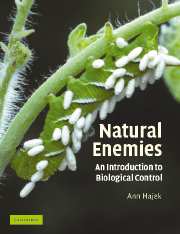Book contents
- Frontmatter
- Contents
- Preface
- Acknowledgments
- Introduction
- PART I Strategies for using natural enemies
- PART II Biological control of invertebrate and vertebrate pests
- Chapter 6 Ecological basis for use of predators, parasitoids, and pathogens
- Chapter 7 Predators
- Chapter 8 Insect parasitoids: attack by aliens
- Chapter 9 Parasitic nematodes
- Chapter 10 Bacterial pathogens of invertebrates
- Chapter 11 Viral pathogens
- Chapter 12 Fungi and microsporidia
- PART III Biological control of weeds
- PART IV Biological control of plant pathogens and plant parasitic nematodes
- PART V Biological control: concerns, changes, and challenges
- Glossary
- References
- Index
Chapter 10 - Bacterial pathogens of invertebrates
Published online by Cambridge University Press: 05 June 2012
- Frontmatter
- Contents
- Preface
- Acknowledgments
- Introduction
- PART I Strategies for using natural enemies
- PART II Biological control of invertebrate and vertebrate pests
- Chapter 6 Ecological basis for use of predators, parasitoids, and pathogens
- Chapter 7 Predators
- Chapter 8 Insect parasitoids: attack by aliens
- Chapter 9 Parasitic nematodes
- Chapter 10 Bacterial pathogens of invertebrates
- Chapter 11 Viral pathogens
- Chapter 12 Fungi and microsporidia
- PART III Biological control of weeds
- PART IV Biological control of plant pathogens and plant parasitic nematodes
- PART V Biological control: concerns, changes, and challenges
- Glossary
- References
- Index
Summary
Bacteria are diverse unicellular organisms that have no internal membrane-bound organelles, making them prokaryotes. They range in size from less than one to several microns long and therefore cannot be seen with the naked eye. Bacteria are ubiquitous, being found in virtually any potential habitats. They use a great diversity of materials as nutrients and divide by fission. Some examples of bacterial associates of invertebrates would be the saprophytic bacteria that live externally on animals and commensals that live within the guts of unwitting hosts, deriving protection from this association.
Some species of bacteria are more integrally involved with invertebrates, living as obligate symbionts within them. For example, bacteria in the genus Buchnera live within specialized host-produced cells, called mycetocytes, within aphids. These bacteria have lived inside aphids for so long that they have few morphological characters that can be used for identification. However, phylogenetic studies using molecular techniques suggest that the association between Buchnera and aphids began 160–280 million years ago (Douglas, 1998). This association is required by the bacteria and the aphids; aphids without Buchnera grow poorly because they depend on these bacteria for essential amino acids and Buchnera cannot be grown outside the aphids.
Pathogens are parasites that are microorganisms and some bacteria have adopted the life history strategy of living as pathogens of invertebrates. Pathogens often cause disease, a term simply meaning an unhealthy state. There are relatively few different species of bacteria specializing in this life strategy.
- Type
- Chapter
- Information
- Natural EnemiesAn Introduction to Biological Control, pp. 180 - 189Publisher: Cambridge University PressPrint publication year: 2004



